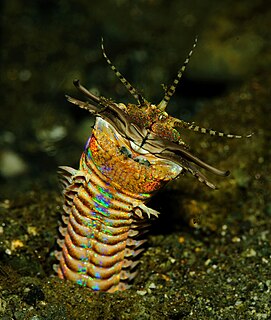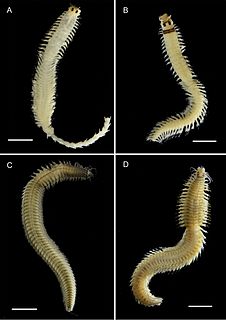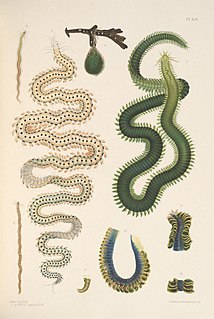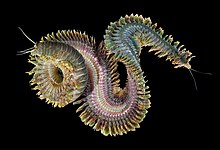
Nereis is a genus of polychaete worms in the family Nereididae. It comprises many species, most of which are marine. Nereis possess setae and parapodia for locomotion. They may have two types of setae, which are found on the parapodia. Acicular setae provide support. Locomotor chaetae are for crawling, and are the bristles that are visible on the exterior of the Polychaeta. They are cylindrical in shape, found in sandy areas, and they are adapted to burrow.

The Terebellidae is a marine family of Polychaete worms, of which the type taxon is Terebella, described by Linnaeus in 1767.

Alitta virens is an annelid worm that burrows in wet sand and mud. It is classified as a polychaete in the family Nereididae.

Pectinariidae, or the trumpet worms or ice cream cone worms, are a family of marine polychaete worms that build tubes using grains of sand roughly resembling ice cream cones or trumpets. These structures can be up to 5 centimetres (2 in) long. The earliest pectinariid fossils are known from the Cretaceous.

Lanice,, is a genus of burrowing marine polychaetes typically found in the littoral zone.

Eunice is a genus in the polychaete family Eunicidae. Individuals grow to a length of between 0.5 and 300 cm. Their bodies have multiple segments. They have two eyes and five tentacles. They have well-developed sense organs and relatively large brains. Their color is dark purple-brown to red-brown with a white ring at the fourth segment. They are found in oceans and seas around the world. They have an evertible proboscis with distinctive mouthparts, some of which comprise two rows of maxilliary plates in a radula-like fashion.

Platynereis is a genus of marine annelid worms.
Janua is a genus of polychaetes, containing the following subgenera and species:

Phyllodoce is a genus of polychaete worms, which contains about 200 species. The prostomium bears eyes, two pairs of antennae and a pair of large retractile nuchal organs. The eversible proboscis is clearly divided into two parts.

The Onuphidae are a family of polychaete worms.

Diopatra is a genus of polychaete worms in the family Onuphidae.
Pettais a genus in the polychaetefamily Pectinariidae.

Ceratonereis is a genus of polychaete worms from the family Nereididae.

Phyllodocidae is a family of polychaete worms. Worms in this family live on the seabed and may burrow under the sediment.

Eulalia is a genus of polychaete worms.
Eulagisca is a genus of marine Polychaete worms belonging to the family Polynoidae. These worms are found in the southern Atlantic Ocean and in the Southern Ocean.
Leucia is a genus of marine polychaete worms belonging to the family Polynoidae, the scaleworms. These worms are found in the northern Atlantic Ocean. This genus is distinguished from the closely related genus Harmothoe by having sixteen pairs of elytra, or scales, as against fifteen.
Leucia nivea is a species of polychaete worm, commonly known as a "scale worm", in the family Polynoidae. This species occurs in the northeastern Atlantic Ocean, the North Sea and the Mediterranean Sea.

Poecilochaetidae is a family of marine worms within the Polychaeta. It is a monotypic family containing the single genus Poecilochaetus. Members of this family are benthic worms that burrow into soft sediments.

Poecilochaetus is a genus of marine worms within the Polychaeta. It is the only genus in the monotypic family Poecilochaetidae. Members of this genus are benthic worms that burrow into soft sediments.
















